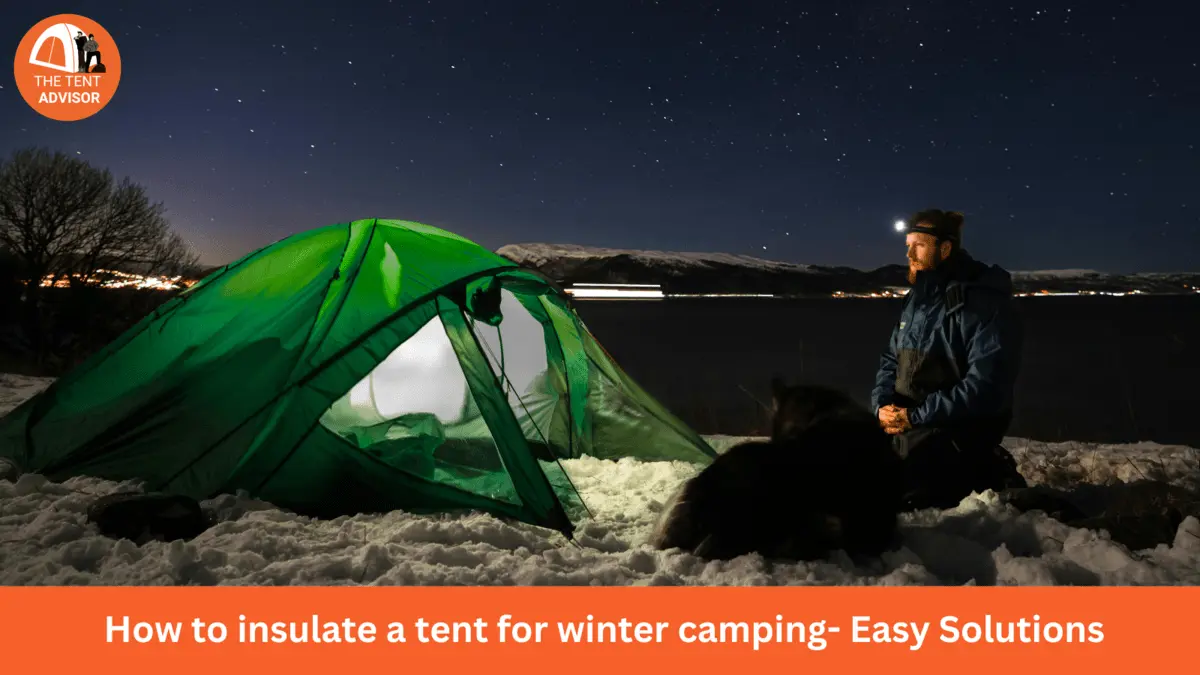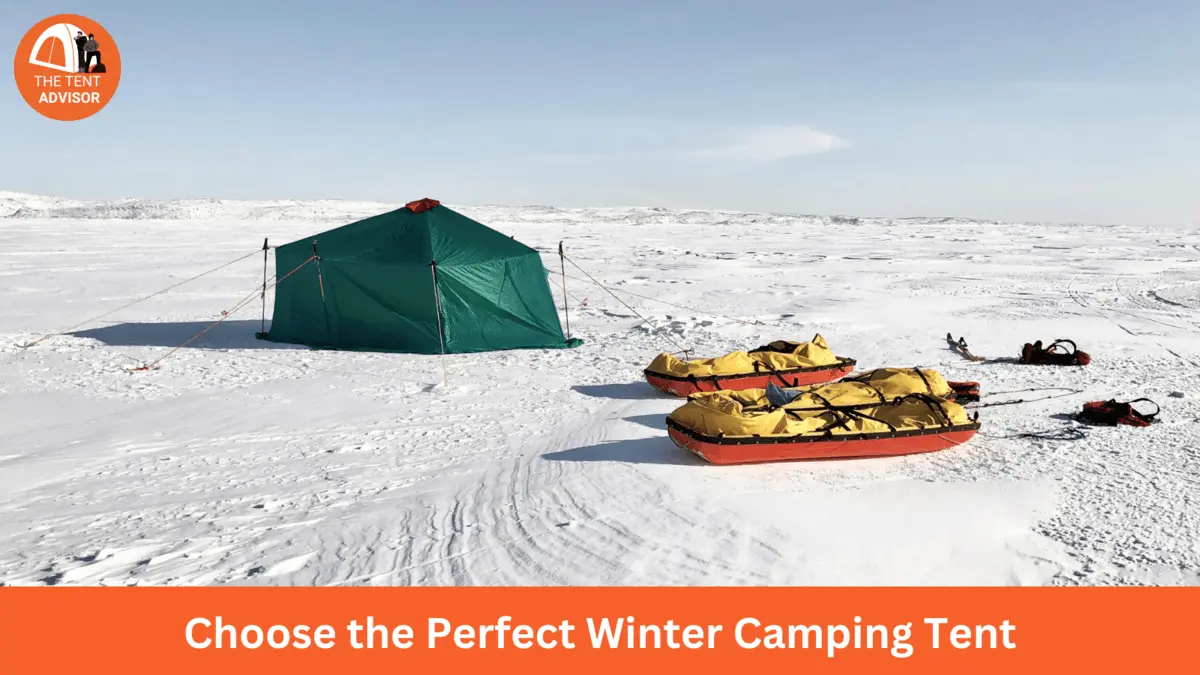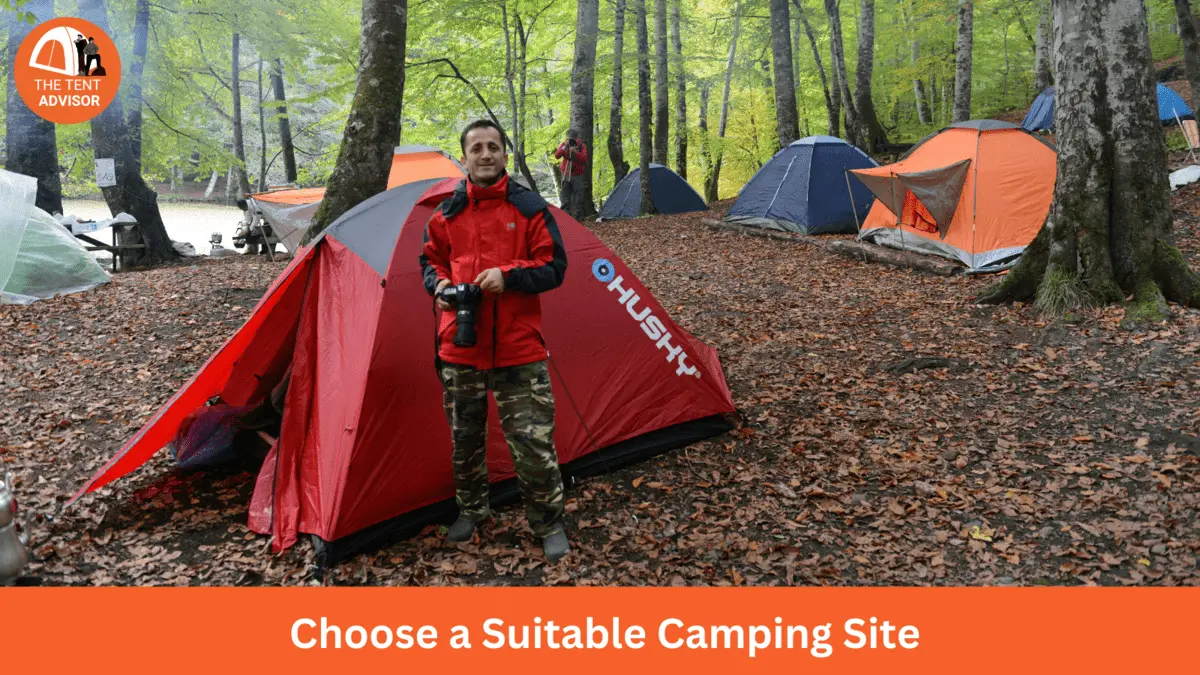Are you braving the chill of winter camping? Transform your tent into a cosy fortress with these top-notch insulation tips! As the winter season starts, one challenge that every camper faces is How to insulate a tent for winter camping.
Winter camping is challenging but more interesting. With the proper preparation, it can also be incredibly rewarding. Proper insulation keeps you warm and ensures a more comfortable and enjoyable experience despite freezing temperatures. From selecting suitable materials to employing innovative techniques, mastering tent insulation can make all the difference between a restful night under the stars and a frosty ordeal.
So , let’s find together all the possible solutions on How to insulate a tent for winter camping
How to insulate a tent for winter camping- Easy Solutions

This advice on how to insulate a tent for winter camping will make your trip memorable and comfortable. Stay with us, and you will find all the tips and secrets.
Get a Smaller tent
To stay warm during winter camping, choose a smaller tent. Compared with small tents, the larger ones are more expensive and consume more energy to heat up and insulate, which is challenging in cold weather.
“Reducing the size of the tent means there is less volume of air that needs to be warmed, making it easier to maintain suitable temperatures inside.
Avoid using large tents for groups; instead, choose one that can comfortably fit each person, as this will result in better heat retention.”
The UNA hammock tent is small and cosy, perfect for camping alone. The Flite tent is another option if you want more room or are camping with a partner; it’s also lightweight and compact.
Insulate your Tent Floor
Insulation on the floor of your tent is essential for retaining warmth in icy environments. Most tents have sleeping pads or cots, but adding extra insulation makes them much warmer and more comfortable.
Put foam pads, thin mats, little rugs, or carpets on the floor of your tent. These separate you from the frozen ground beneath your body by capturing heat, improving your night’s rest experience. Dry leaves or straws can serve as alternatives where these materials are unavailable at an affordable price. Just spread them under your tent if you want added warmth while camping on chilly nights. This method is also cost-effective and adds cosiness to any tent.
Buy a Tent Heater
Keeping a tent warm during winter can be done using simple methods, including owning a tent heater. They come in different types; electric models, for example, are characterized by quick heating capacity for their internal spaces, apart from other features that simplify their operations.
In contrast, propane models do not require electricity when used outdoors or away from plugs because they utilize gas cylinders as their source of fuel, which they burn to produce heat.
This makes them an ideal camping accessory for people who often go out into the woods and do not stay in areas with electrical connections, like national parks or forest preserves.
The tent size and the kind of fuel you need should be taken into account when choosing a model. Propane heaters are mostly used during camping trips without electricity since they can be easily transported.
On the other hand, unlike propane models, electric heaters require a power outlet and offer steady warmth.
However, it is crucial to prioritize safety when using a tent heater. Gas-powered models can produce open flames and emit carbon monoxide, so they should be handled with care.
Proper ventilation systems are also important to prevent harm to users’ health within the enclosed environment. Even if the heater is designed for indoor use, always consult the manufacturer’s manual before installation.
Tent stoves are useful for cooking, but they can never replace heaters as they lack many security features inherent in modern tent heating devices, exposing campers to serious risks, including fires and carbon monoxide poisoning.
Therefore, a person has to buy a particular tent heater designed by professionals specifically for this purpose for heating during outdoor hobbies like camping.
Choose the Perfect Winter Camping Tent

The choice of the tent is critical during winter camping. You will need a winter-specific tent to endure the harsh cold conditions. Search for tents marked as “four-season” or “winter-insulated.”
For instance, four-season tents are usually made to bear heavy snow loads and strong winds, which makes them very suitable for winter conditions. Another good option is insulated pop-up tents; they can provide extra warmth and protection from the elements.
Those camping with RVs should consider bringing an insulated grow tent to protect plants and keep the air inside their RV warm and cosy.
This article will help you choose the right tent to enhance your experience by providing more insulation and protection against cold.
Choose a Suitable Camping Site

The place where you set up camp greatly matters regarding winter camping comfortability. A good campsite should offer natural protection from weather elements, thus minimizing exposure to coldness due to poor position selection.
When there are trees around, you can pitch your tent near them to get some windbreak naturally, hence reducing the impact of cold winds and snow on your tent; such trees may also act as barriers that make this area less affected by severe weather conditions like storms that prevail on open grounds.
In cases with no trees, one could find natural shelters like hills or features on terrains that cut off wind directions or snow drifts. Picking a spot for your shelter in such situations can shield it against the prevailing wind direction, retaining heat and leading to a warmer environment.
For detailed information read this article.
Cover Your Tent’s Exterior
To prevent heat from escaping through the tent walls and roof, you can insulate the exterior of your tent. The outside of your tent can be covered with an insulating blanket or reflective material to prevent heat leakage through its walls and ceiling fabrics.
Another option is thermal blankets, such as foil coatings or space blankets. These materials help to keep the heat in and provide an extra layer of defence against the elements, including rainfall and wind. Ensure that you cover it tightly so it can wrap around the whole tent.
Line Your Tent’s Roof and Walls
If you need more than your exterior coverings, try lining the inside of your tent with insulating fabric. Thermal or space blankets can be used to line the floor and ceiling of the tent if cut into appropriate sizes. This additional insulation keeps the heat in and provides more protection against coldness.
For insulating fabric, you can buy insulation sheets or paneling from a hardware store. Correctly lining your tent’s interior using these materials leads to well-insulated winter camping sites.
Obtain a Tent Groundsheet
When camping in winter, keeping your tent off the cold and damp ground is essential. The tent footprint creates an extra insulation layer between your tent and the ground.
Ensure it covers the entire tent floor so moisture cannot creep through. It will also help to keep your food dry and out of reach from chilly weather.
Build a Snow Wall
If you are camping in an area with heavy snowfall, you can use it by building a wall from snow outside your tent. A snow wall around 4 to 5 feet high acts as a shield against freezing winds and helps insulate your tent.
In snowy environments, this approach works best and adds another protective blanket against the harshness of nature. To achieve the most secure results, make sure that the snow wall is solidly built to completely enclose the interior area of your tent.
Carry hot bags
Heat packs are a small, compact way to warm your winter camping setup. When activated, these little one-time-use pouches give off heat and can be put around the tent where you want additional warming. Warmth can be added by placing them beneath the pillow, within the blanket or jacket trousers pockets, enhancing their heating effectiveness, especially if put under blankets while inside jackets, sweaters, etc.
Ensure that you arrange them well at different parts of your tent so that they give just enough heat. Still, you should exercise caution as heat packs get very hot, which could burn you if you are not careful; therefore, you should ensure they are always wrapped in clothes or bedding.
Get a four-season tent.
The selection process for winter camping depends on getting the right tent, with a four-season one being most suitable for cold and snowy locations and conditions. Four-season tents differ from three-season tents, which have mesh canopy panels that allow more air circulation during summer. Still, they have thicker fabric designed to keep out cold temperatures.
During winter storms, four-season tents will help keep you warm, for instance, by reducing thermal loss through conduction, among other mechanisms of losing heat, since these shelters are generally built to withstand such weather conditions. One of the ways to guarantee a peaceful night throughout freezing nights is getting yourself a 4 season tent.
Use a tarpaulin to break the wind.
While camping during winter, windy conditions will significantly impact your warmth and comfort. Even when there is no breeze, it is easy to feel chilled because of the wind chill, which makes cold temperatures seem much colder.
In addition to using your tent’s rain fly, position a camping tarp as wind blockage. Erect in such a way that it faces directly opposite where winds would blow due to bad weather and thus prevent gusts from reaching you, creating an environment inside with less chilled air. What this translates into is sustained warmth even during storms of heavy magnitude.
Insulate with foam pads.
You can also lay down some foam padding within your tent to further insulate your body from the freezing ground. Although footprint or groundsheets help keep out external elements like moisture, they don’t provide insulation from below.
Even if you are sleeping on top of a pad or cot, foam padding will help keep you warm since it blocks heat transfer between the tent’s floor and cold ground just below you, an essential tip for winter camping. Due to its easy installation and low cost, people buy large sizes whenever they want them for use in cold seasons, hence making it a popular means of insulation in those periods.
Bring Rugs/old carpets.
Another trick could be lining the bottom with carpets or rugs retrieved from our old houses. While these materials may not have thermal resistance similar to foams, they make excellent insulators beneath tents for sleeping bags. They can trap some warmth beneath our bodies, thus preventing heat leakage through floors while moving up towards the open sky above us through tent walls.
If you lack rugs or carpets, blankets can be used instead. But because they are less long-lasting than rugs, use them gently and cautiously so as not to damage them. Rugs and carpets work well in insulating your tent and bring a more homely feeling even on a cold night.
Wind Breaks
Put up windbreaks around the sides of your tent to prevent cool drafts from entering.
Tentsile Walls: The tents have sidewalls that act as windbreakers, helping to retain warmth within the tent. In addition, there is extra space below the tent, which provides shelter for gear and setting up camp.
Sleeping Bag
A comfortable sleeping bag that keeps you warm is essential when going camping. Here’s what to look for:
Mummy Sleeping Bag: This sleeping bag has a tight fit and a drawstring hood that keeps body heat inside. It is explicitly designed to keep you warm and cosy.
Temperature Rating: If you are spending the night in very cold weather, select a sleeping bag with a sub-zero rating. This rating shows how low the bag can be used in terms of temperature.
Ethically Sourced Down: If you buy a filled sleeping bag, ensure it is obtained ethically so that it can be sourced responsibly regarding rights and environmental conservation.
Heat Packs
In addition, if necessary, try using heat packs:
Heat Packs: These are portable packets of heat energy that emit warmth for the user when placed inside their sleeping bags while they are asleep.
Hot Water Bottle: Another option is to use a hot water bottle. Boil some water, pour it into the bottle, and then place it inside your sleeping bag. This will keep your feet warm during frosty nights.
To prepare for camping during the colder season, prepare these essentials beforehand.
How to insulate a tent for winter camping-Final Verdict
We have covered everything about how to insulate a tent for winter camping; we hope you like it.
Winter camping may pose unique challenges, but with proper organization, one can keep oneself warm and comfortable despite the cold. First, select a tent designed specifically for winter conditions and choose a site that offers natural defences from the elements.
From this point, insulate your dwelling place through methods such as floor coverings, exterior blankets, interior liners, and heat packs. Following these steps can enhance your winter camping experience and allow you to enjoy the cold season safely and comfortably. Have a great winter camping!
FAQs: How to insulate a tent for winter camping
How can I keep my tent warm without electricity?
Choose an insulated tent designed for cold weather so you can stay warm in your tent without electricity. Bring a heated blanket or hot water bottles to help retain body heat. Use a layer of insulation, such as foam pads or thermal blankets, to prevent cold from seeping through the ground. Position your tent in a sheltered spot to shield it from the wind.
Does a tarp over a tent keep it warmer?
Setting up a tarp over your tent can help keep it warmer. The tarp protects against cold winds and snow, reducing heat loss through the tent’s roof. It also helps minimize condensation build-up, keeping the interior drier and warmer.
How do you warm up the inside of a tent?
To warm up the inside of your tent, use methods such as hot water bottles, heated blankets, or ground insulation. These options help retain body heat and prevent cold from penetrating. While electric and propane heaters can also be used safely, they must be adequately secured, kept away from flammable materials, and well-maintained to ensure safety.
